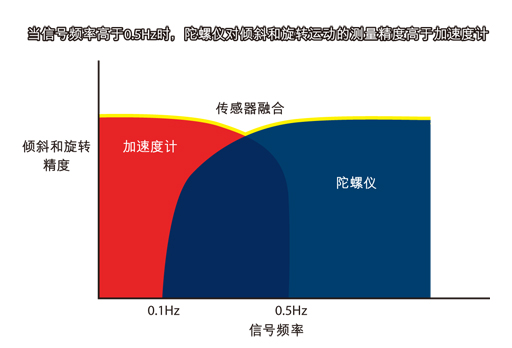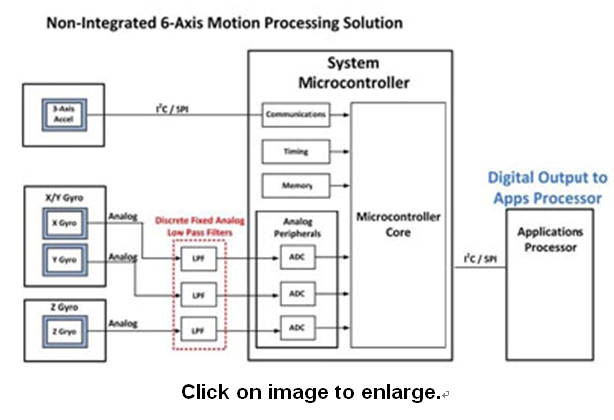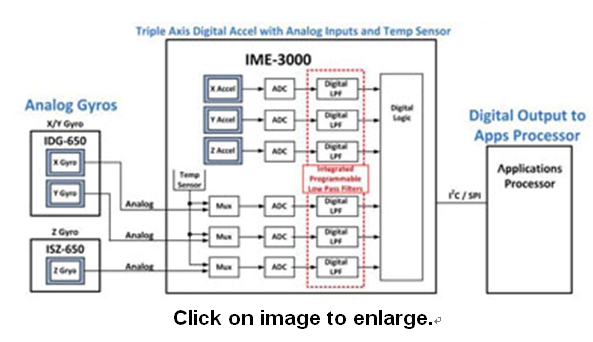The motion processing technology that measures and intelligently processes the motion of the device in three dimensions will be the next major revolutionary technology that will have a major impact on future handheld consumer electronic devices, human-machine interfaces, and navigation and control.
This article refers to the address: http://
The driving force behind this change is the Micro-Electro-Mechanical Systems (MEMS) consumer-grade inertial measurement unit (IMU). Combined with six-axis motion processing technology, these devices provide a simpler and intuitive user interface for navigation and control of handheld consumer electronics, addressing the operational complexity of these complex devices that confuse many users.
The key component of this MEMS-based motion processing-based six-axis control is the recently introduced smaller, lower cost, higher performance, three-axis MEMS gyroscope that can be combined with existing three-axis MEMS accelerometers.
This article will present a six-axis motion processing solution and explore the key issues to consider when integrating this technology into a consumer electronics system. When implementing a new design using six-axis motion processing, ensuring compliance with the four key factors presented in this article improves integration efficiency and delivers superior performance in the end user equipment.
Motion processing application
At the Electronic Entertainment Expo (E3), the three major console brands showcased a motion-driven human-machine interface developed for their current or next-generation systems. Among them, Nintendo is the first to announce the inclusion of six-axis motion processing in Wii MotionPlus accessories. Program. Some game software developers have quickly introduced a new game that can take advantage of six-axis motion processing: Nintendo will launch the Wii Sports Resort, a sequel to the Wii Sports game, in July 2009. Early product evaluations showed that screen game control using motion processing technology had higher tracking accuracy for controller motion and achieved 1:1 tracking.
As consumers have embraced the new features offered by the three-axis accelerometer, the handset will be the next frontier in motion processing. Apple's iPhone is a good example. Currently, Apple continues to develop unique motion sensing applications, including adding a shake-to-undo function to its iPhone 3.0 that can be undone during copying and pasting. Adding six-axis motion processing to future mobile phones and other handheld consumer electronic systems can provide software developers with absolute position in three-dimensional space with greater precision, accuracy and responsiveness, enabling console gaming performance.
This is a fast-changing environment. In the past, the first products with traditional buttons and pulleys were the key to design success; today, success will depend on who can create the most attractive user experience, because relying on six Axis motion processing, complex control and navigation commands can now be performed with normal gestures.
Motion treatment plan
The key technology that provides motion processing capabilities is the gyroscope traditionally used to measure absolute rotation rates. The vibration mass gyroscope uses the Coriolis acceleration to produce energy transfer between two resonance modes of a structure. The Coriolis acceleration appears in the rotating reference coordinate system and is proportional to the rotational angular velocity, see Figure 1. The gyroscope obtains angular velocity (Ω) by measuring Coriolis acceleration.

Figure 1: Coriolis acceleration occurs in the rotating reference plane, proportional to the rate of rotation.
A vibrating tuning tuning fork mass gyroscope typically includes a pair of vibrating masses of equal amplitude and opposite direction. When the gyroscope rotates, the Coriolis force causes an orthogonal vibration force proportional to the rotational angular velocity. A good gyroscope design should have high Coriolis acceleration and low mechanical noise. To achieve a large Coriolis acceleration requires inertial mass to have a higher speed (this speed is generated by electrostatic force), to achieve high sensitivity requires that the integrated circuit (IC) has a lower amplification factor to reduce noise.
While accelerometers provide basic motion sensing for simple azimuth and tilt applications, in more complex applications such as optical image stabilization (OIS), there are some limitations that affect accelerometer operation and performance. Accelerometers only provide the sum of linear and centripetal acceleration, gravity, and vibration. It is necessary to add a gyroscope to extract a certain component of the linear motion information of the acceleration. In a motion processing scheme, the gyroscope must accurately measure the angular velocity rotational motion.
To correct the rotational error of the accelerometer, some manufacturers use magnetometers to perform the sensing functions traditionally implemented with gyroscopes. These devices determine the rotational motion of the handheld device relative to the magnetic north direction and are typically used to adjust the display orientation of the map to correspond to the direction the user is currently facing. Magnetometers are incapable of achieving fast rotation measurements (greater than 5 Hz) and, in the presence of external magnetic fields (such as speakers, audio headphones), and even when ferromagnetic materials are present around the device, the data is susceptible to contamination. The gyroscope is the only inertial sensor that provides accurate, non-delayed rotational measurements and is immune to any external forces such as magnetism, gravity or other environmental factors.
Silicon MEMS-based technology not only brings new MEMS gyroscopes that meet the cost of consumer electronics, but is also expected to meet challenging industry cost targets of less than $1.00 per axis. In addition, the new gyroscopes also meet mobile phones. The requirements for package size and rotational sensing accuracy for game controllers, remote controls and portable navigation devices. The small size, high performance, low cost MEMS gyroscope and its associated MEMS accelerometer have made the motion processing solution a reality.
Both gyroscopes and accelerometers are required
To meet the end user's functional expectations, you need to get information on three-axis rotary motion and three-axis linear motion. A common misconception is that in order for a handheld system to have motion processing capabilities, engineers need to add a gyroscope or accelerometer, that is, just choose one. Indeed, there have been industry analysts asking the question, "Which one will win in the motion sensor competition?"
In fact, to accurately describe linear and rotational motion, designers need to use both gyroscopes and accelerometers. The gyro-only solution can be used for rotation detection that requires high resolution and fast response; the scheme using the accelerometer alone can be used with a fixed gravity reference coordinate system, linear or tilting motion, but the rotational motion is limited to a certain range. application. However, when dealing with linear motion and rotational motion, a gyroscope and accelerometer scheme is required.
When tracking tilt and rotary motion, the accelerometer provides more accurate acceleration measurements when the device is not moving, while the MEMS gyroscope measures more accurately when the device is moving. As shown in Figure 2, sensor fusion algorithms are commonly used to combine accelerometer and gyroscope data to achieve accurate rotation measurements over a wide frequency band.

Figure 2: The sensor fusion algorithm combines the data from the accelerometer and the gyroscope to cover a wider range of motion signal frequencies.
Choosing the right motion processing solution requires careful analysis of multiple factors, including the device's full-scale range, sensitivity, offset performance, noise, cross-axis sensitivity, and the effects of temperature, humidity, and mechanical acceleration vibration on the product. Next we focus on four key factors to consider when using these sensors in a consumer electronics system.


Rice Mill,Rice Mill Machine,Small Rice Milling Machine,Rice Mill Equipment
Hunan Furui Mechanical and Electrical Equipment Manufacturing Co., Ltd. , https://www.frcornthresher.com